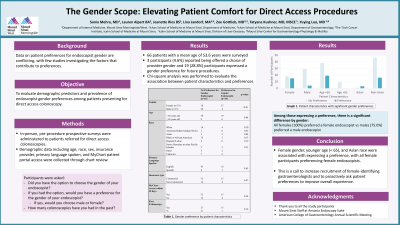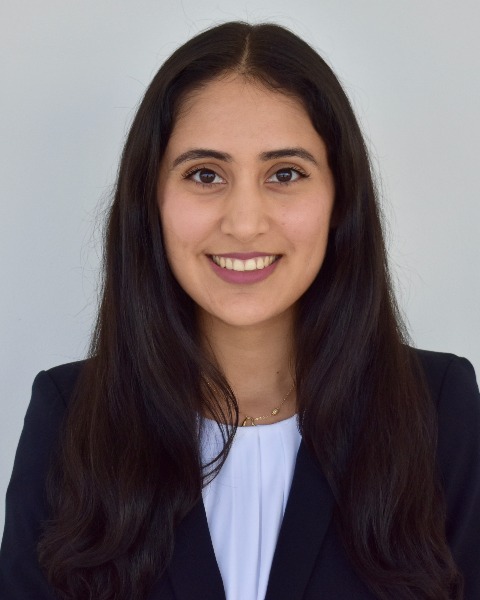Tuesday Poster Session
Category: Practice Management
P4922 - The Gender Scope: Elevating Patient Comfort for Direct Access Procedures
Tuesday, October 29, 2024
10:30 AM - 4:00 PM ET
Location: Exhibit Hall E

Has Audio

Sonia Mehra, MD
Mount Sinai Morningside, Icahn School of Medicine at Mount Sinai
New York, NY
Presenting Author(s)
Sonia Mehra, MD1, Lauren Alpert, BA2, Jeanette Rios, BS2, Lina H. Jandorf, MA2, Zoë S.. Gottlieb, MD3, Tatyana Kushner, MD, MSCE2, Yuying Luo, MD4
1Mount Sinai Morningside, Icahn School of Medicine at Mount Sinai, New York, NY; 2Icahn School of Medicine at Mount Sinai, New York, NY; 3Mount Sinai Hospital, New York, NY; 4Mount Sinai Center for Gastrointestinal Physiology & Motility, New York, NY
Introduction: Data on patient preferences for endoscopist gender are conflicting, with few studies investigating the factors that contribute to preferences. We aimed to evaluate demographic predictors of endoscopist gender preferences among patients presenting for direct access colonoscopy.
Methods: In-person, pre-procedure prospective surveys were administered to patients referred for direct access colonoscopies. Participants were notified that their survey responses would not impact their current procedure. Demographic data including age, race, sex, insurance provider, primary language spoken, and MyChart patient portal access were collected through chart review. A Chi-square analysis was performed to evaluate the association between variables of interest and patients’ endoscopist gender preference.
Results: Our cohort included 66 patients with a mean age of 53.6 years (SD= 9.4). Half (50%) of the participants were female, and the majority (69.7%) were non-white (Table 1). Of the study participants, 92.4% preferred English as their primary spoken language, 72.7% used commercial health insurance, 75.8% accessed MyChart within the past thirty days, and 63.6% reported that this was their first colonoscopy. Only 3 participants (4.6%) reported being offered a choice of provider gender prior to their procedure and 19 (28.8%) participants expressed a gender preference for future procedures. There was a significant difference in preference by patient gender (45.5% women vs 12.1% men, p < 0.01), patient age (33.3% < 65 years old vs 0% > 65 years old, p = 0.04), and Asian race (75.0% Asian vs 25.8% non-Asian, p = 0.04). Among those with a preference, there was a significant difference by patient gender, where all females (100%) preferred a female endoscopist vs males (75.0%) preferred a male endoscopist, p < 0.01). There was no significant difference in preference when accounting for insurance type, primary language spoken, first colonoscopy, or MyChart access.
Discussion: In a patient population presenting for direct access colonoscopies, over a quarter of participants expressed gender preference for their endoscopist; however, only three were asked about preference before their procedure. Female gender, younger age (< 65), and Asian race were associated with expressing a preference, with all female participants preferencing female endoscopists. This is a call to increase recruitment of female-identifying gastroenterologists and to proactively ask patient preferences to improve overall experience.
Note: The table for this abstract can be viewed in the ePoster Gallery section of the ACG 2024 ePoster Site or in The American Journal of Gastroenterology's abstract supplement issue, both of which will be available starting October 27, 2024.
Disclosures:
Sonia Mehra, MD1, Lauren Alpert, BA2, Jeanette Rios, BS2, Lina H. Jandorf, MA2, Zoë S.. Gottlieb, MD3, Tatyana Kushner, MD, MSCE2, Yuying Luo, MD4. P4922 - The Gender Scope: Elevating Patient Comfort for Direct Access Procedures, ACG 2024 Annual Scientific Meeting Abstracts. Philadelphia, PA: American College of Gastroenterology.
1Mount Sinai Morningside, Icahn School of Medicine at Mount Sinai, New York, NY; 2Icahn School of Medicine at Mount Sinai, New York, NY; 3Mount Sinai Hospital, New York, NY; 4Mount Sinai Center for Gastrointestinal Physiology & Motility, New York, NY
Introduction: Data on patient preferences for endoscopist gender are conflicting, with few studies investigating the factors that contribute to preferences. We aimed to evaluate demographic predictors of endoscopist gender preferences among patients presenting for direct access colonoscopy.
Methods: In-person, pre-procedure prospective surveys were administered to patients referred for direct access colonoscopies. Participants were notified that their survey responses would not impact their current procedure. Demographic data including age, race, sex, insurance provider, primary language spoken, and MyChart patient portal access were collected through chart review. A Chi-square analysis was performed to evaluate the association between variables of interest and patients’ endoscopist gender preference.
Results: Our cohort included 66 patients with a mean age of 53.6 years (SD= 9.4). Half (50%) of the participants were female, and the majority (69.7%) were non-white (Table 1). Of the study participants, 92.4% preferred English as their primary spoken language, 72.7% used commercial health insurance, 75.8% accessed MyChart within the past thirty days, and 63.6% reported that this was their first colonoscopy. Only 3 participants (4.6%) reported being offered a choice of provider gender prior to their procedure and 19 (28.8%) participants expressed a gender preference for future procedures. There was a significant difference in preference by patient gender (45.5% women vs 12.1% men, p < 0.01), patient age (33.3% < 65 years old vs 0% > 65 years old, p = 0.04), and Asian race (75.0% Asian vs 25.8% non-Asian, p = 0.04). Among those with a preference, there was a significant difference by patient gender, where all females (100%) preferred a female endoscopist vs males (75.0%) preferred a male endoscopist, p < 0.01). There was no significant difference in preference when accounting for insurance type, primary language spoken, first colonoscopy, or MyChart access.
Discussion: In a patient population presenting for direct access colonoscopies, over a quarter of participants expressed gender preference for their endoscopist; however, only three were asked about preference before their procedure. Female gender, younger age (< 65), and Asian race were associated with expressing a preference, with all female participants preferencing female endoscopists. This is a call to increase recruitment of female-identifying gastroenterologists and to proactively ask patient preferences to improve overall experience.
Note: The table for this abstract can be viewed in the ePoster Gallery section of the ACG 2024 ePoster Site or in The American Journal of Gastroenterology's abstract supplement issue, both of which will be available starting October 27, 2024.
Disclosures:
Sonia Mehra indicated no relevant financial relationships.
Lauren Alpert indicated no relevant financial relationships.
Jeanette Rios indicated no relevant financial relationships.
Lina Jandorf indicated no relevant financial relationships.
Zoë Gottlieb indicated no relevant financial relationships.
Tatyana Kushner: Gilead – Advisor or Review Panel Member, Grant/Research Support. GSK – Advisory Committee/Board Member.
Yuying Luo indicated no relevant financial relationships.
Sonia Mehra, MD1, Lauren Alpert, BA2, Jeanette Rios, BS2, Lina H. Jandorf, MA2, Zoë S.. Gottlieb, MD3, Tatyana Kushner, MD, MSCE2, Yuying Luo, MD4. P4922 - The Gender Scope: Elevating Patient Comfort for Direct Access Procedures, ACG 2024 Annual Scientific Meeting Abstracts. Philadelphia, PA: American College of Gastroenterology.
